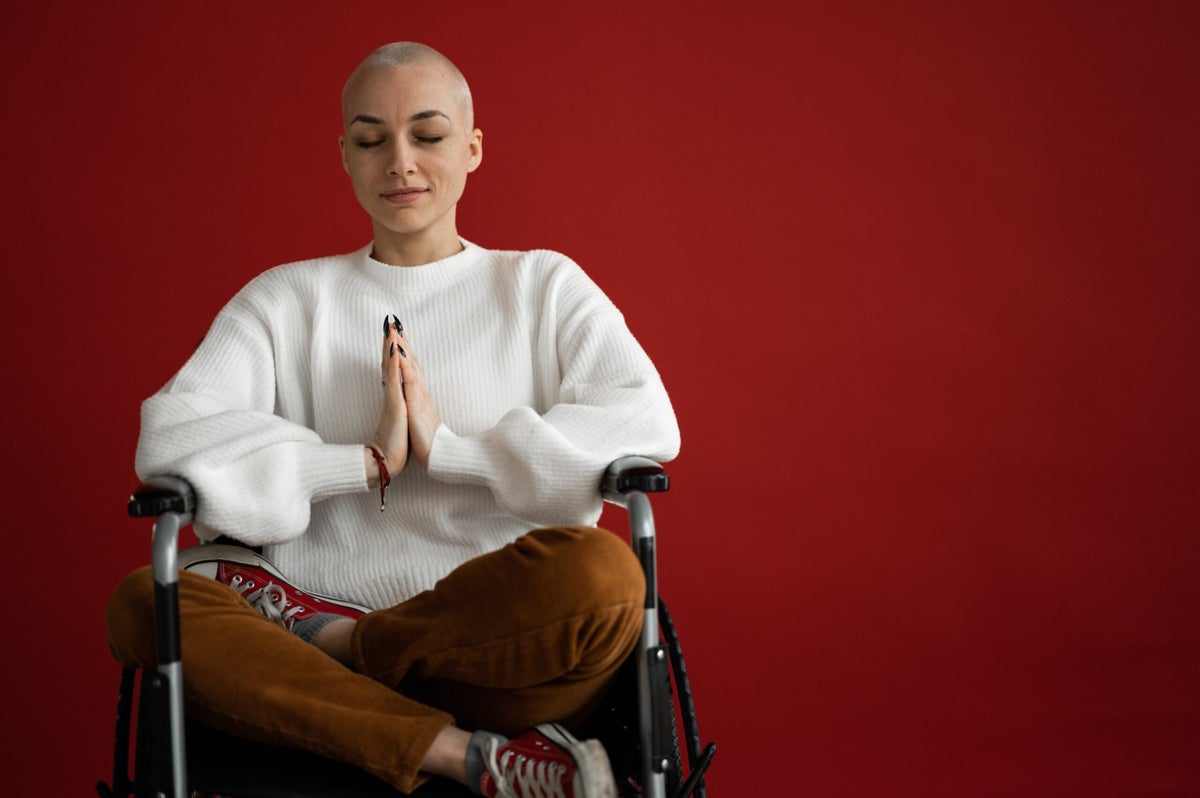
Ask the Teacher is an advice column that connects Yoga Journal members directly with our team of expert yoga teachers. Every other week, we’ll answer a question from our readers. Submit your questions here, or drop us a line at asktheteacher@yogajournal.com.
I’m hoping you have suggestions for how to do wheelchair yoga.
—Jodi
We thought this was a good question for Rodrigo Souza. Based in southern Sweden, he teaches adaptive yoga virtually and leads yoga and mindfulness at camps for people who have experienced traumatic injuries. Souza prefers the term “adaptive yoga” to “wheelchair yoga” because the former includes a wider range of students who can benefit, but might not need or use a wheelchair.
Adapting to a changing body
Originally from Brazil, Souza lived in London where he worked as a DJ before moving to Sweden. He was a climber and had practiced yoga for several years before he suffered a traumatic injury in 2014 that left him paralyzed from the chest down. He delved more deeply into yoga to ease the physical and emotional pain of his injury.
He studied with Matthew Sanford, whom he calls “the jedi of adaptive yoga.” Sanford, who was 13 when he was left paraplegic after an automobile accident, studied with BKS Iyenger and learned adaptations of all the asana variations. Today, there are a number of
What is adaptive yoga?
Adaptive yoga is a way to make the practice of yoga more accessible to everyone, regardless of shape, mobility, or energy level. It’s yoga for folks who have a spinal-cord injury, multiple sclerosis, or Parkinson’s, or who have experienced a stroke. It’s helpful in adaptive yoga to find a specific teacher especially for the population.
Instead of just showing a flow in a class and having everyone doing the same thing, an adaptive yoga teacher works with your disability and with your ability. We look at what you can do.
How is adaptive yoga different?
In addition to creating variations of poses to accommodate unique bodies, adaptive yoga teachers create variations in sensations, explains Souza. “We’re going to work with sensations of grounding. We’re going to create a more meditative practice. So we are more interested in the posture experience than the perfect physical manifestation of the posture.”
Classes are generally taught in small groups—five or six students at the most—with people with the same condition. That is very important because adaptive yoga students may have different abilities, says Souza. “For example, I am paralyzed from the chest down. If you take someone who has gone through a stroke, they’re going to be a hemiplegic. They’re paralyzed, but they’re paralyzed on either the left side or the right side. So the asana variations that work on my body will not work for them.”
These groups have social benefits as well, Souza says. “Having a disability is a very lonely experience. When you hang out with folks who have gone through the same thing, you create a natural bond with them.”
What to look for in adaptive yoga classes
A non-disabled person looks for the same thing anyone else would look for in a yoga class: a teacher who nurtures a sense of emotional, physical, and psychological well being. Be willing to seek out different classes and different teachers to find a good fit. There are many virtual class offerings.
You can take classes with people of different abilities in the same room, but it’s going to be more challenging for the teacher, Souza says. They need to be sure to move the class in the same direction and make sure everyone is included. Having assistants to help take care of each person helps.
Mental health benefits of adaptive yoga
“Yoga teaches you self-compassion; it teaches you self-acceptance,” Souza says. He says yoga has helped him to be “in love with [his] broken body and to accept it as it is.” He believes everyone, including people with disabilities, should have access to yoga and be able to practice it.
He named his virtual yoga studio Allihopa, his favorite Swedish word. He says that translates to “everybody, all people, altogether, with each other, with one another.” It’s a term that aligns with the principles of yoga and with the mission of his work: “to make Yoga accessible for everyone, for everybody, all together, with one another.”
Adaptive yoga resources
If you want to take adaptive yoga classes or learn more about teaching adaptive yoga, here are some resources:
- Through Allihopa Yoga, Rodrigo Souza offers virtual classes on a sliding scale, as well as a workshop for yoga teachers.
- Matthew Sanford offers classes and workshops through mindbodysolutions.org. You can also find videos on the Mindbody Solutions YouTube channel, “The Hub.”
- Read Adaptive Yoga by yoga teacher and internal medicine physician Ingrid Yang, MD. She also teaches adaptive yoga classes and conducts teacher trainings virtually and on-site.
- Accessible Yoga offers classes, workshops, and teacher training to all marginalized people, including those who use wheelchairs or have other physical disabilities. Founder Jivana Heyman also wrote Accessible Yoga: Poses and Practices for Every Body
Got a question about alignment in a certain yoga pose? Want to better understand an aspect of yoga philosophy? Need advice on how to approach a challenging situation in your class? Submit your questions here or email us at asktheteacher@yogajournal.com, and we may answer it in an upcoming column.





